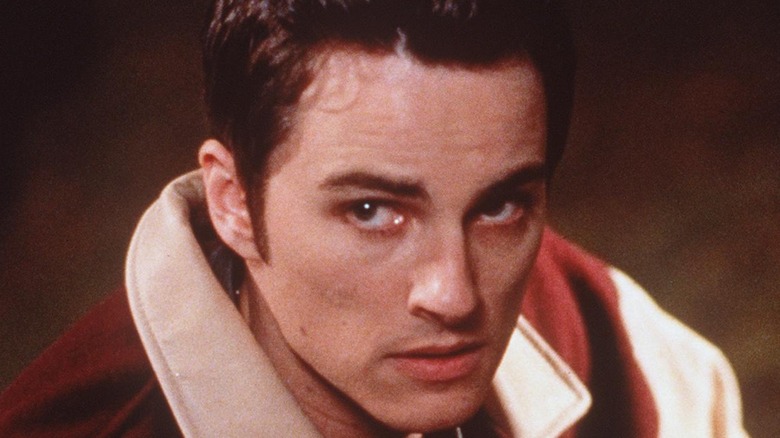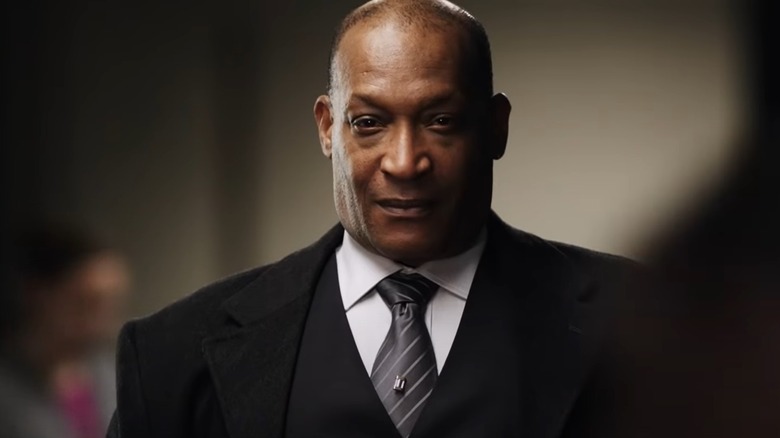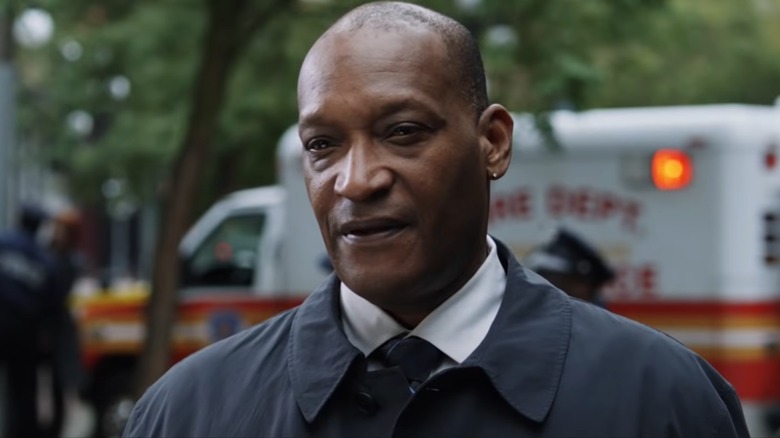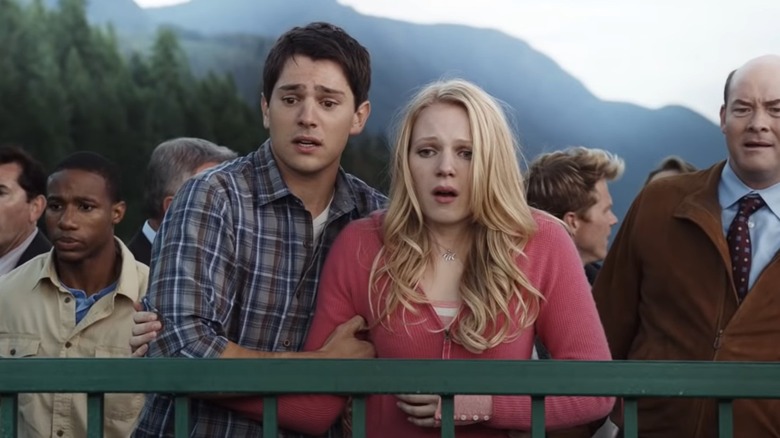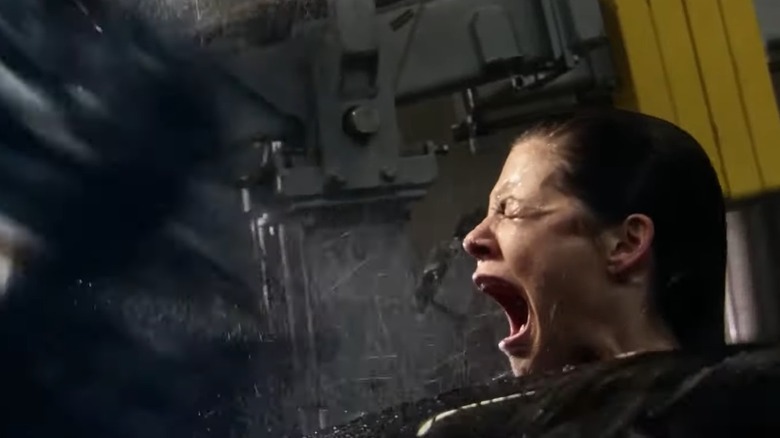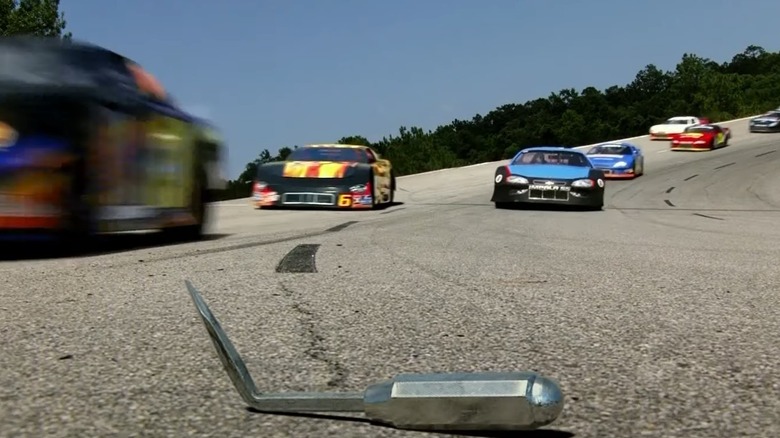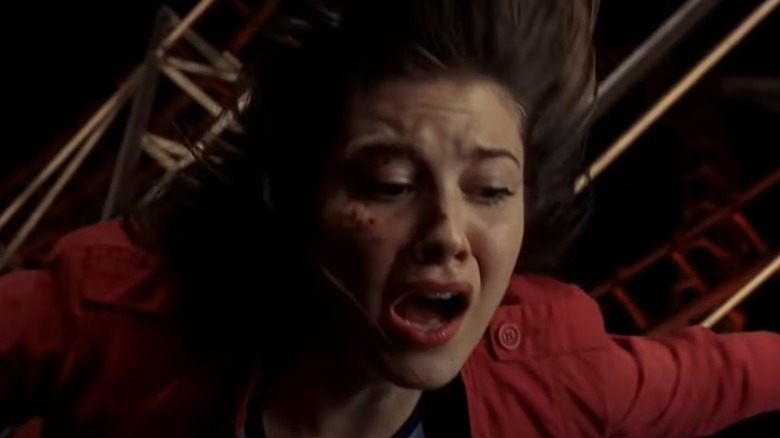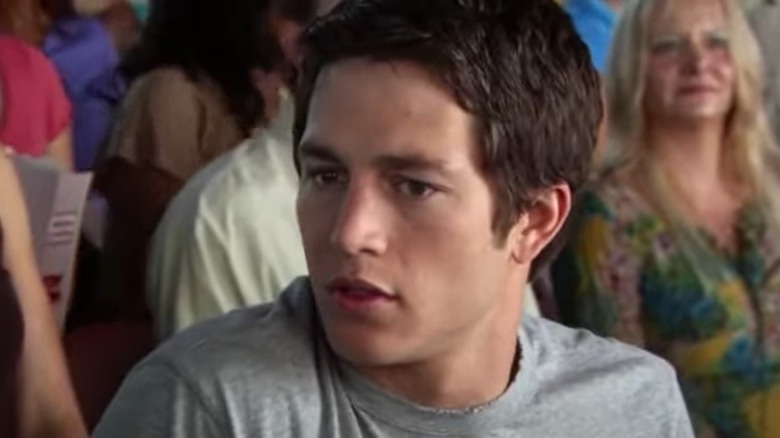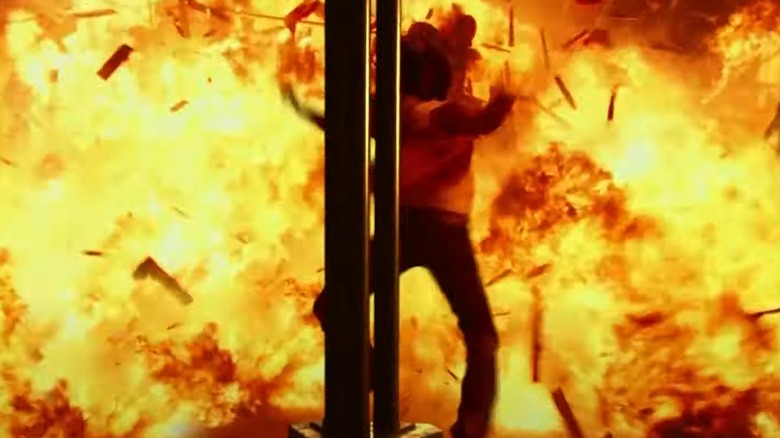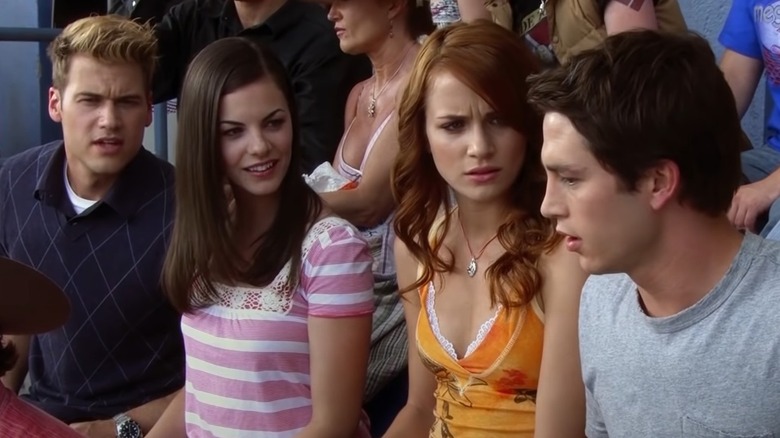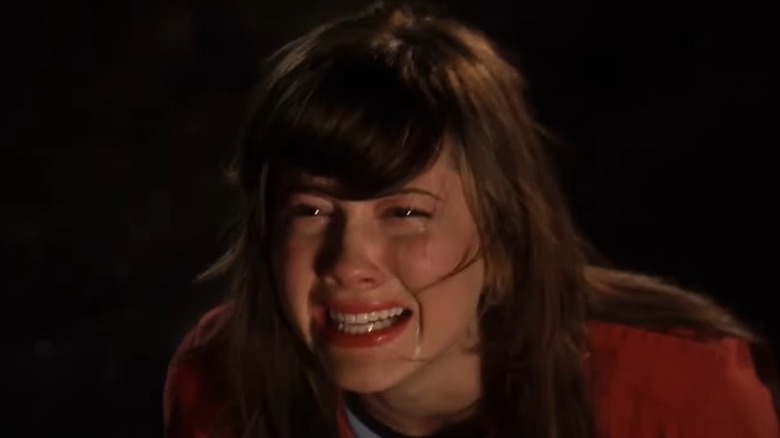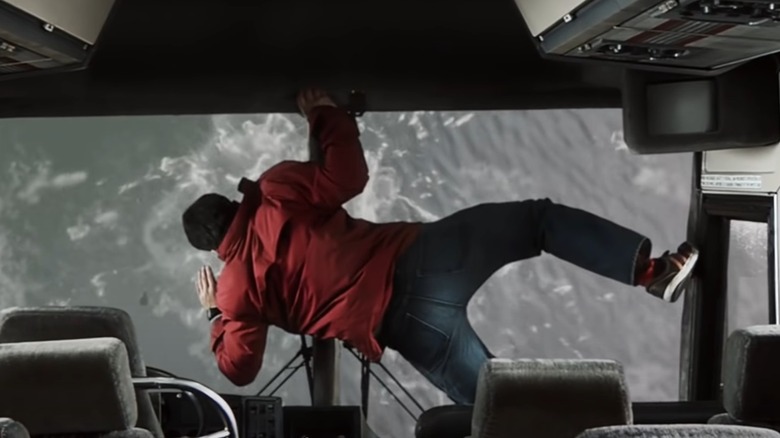Questionable Things We Ignore In The Final Destination Movies
Slasher movies revolve around a group of young adults trying to outrun a violent force that attempts to kill them off one by one. In the "Final Destination" film series, the characters aren't trying to escape a single person, but Death itself. Each film revolves around one person having a premonition where they and several others die in a horrific accident. And when the survivors start dying in violent ways, they must figure out how to cheat Death as much as possible.
Like most horror movies, the "Final Destination" series isn't built around logic. In fact, the series has become infamous for outrageous and nonsensical death sequences that are more comedic than scary. Indeed, once you get past all the blood and gore, you'll find that the series raises more questions than answers. Here are some head-scratching moments from the "Final Destination" films.
Who Exactly Is William Bludworth?
Every "Final Destination" film revolves around a new group of people, but some characters do carry over between films. The character that has appeared the most in the series is William Bludworth (Tony Todd), a mortician who seems to have a large amount of knowledge about Death. In the original "Final Destination," Bludworth informs protagonists Alex (Devon Sawa) and Clear (Ali Larter) about the situation they are in and how Death will continue to come for them. Bludworth continued to make return appearances in two more films in the series to instruct survivors about Death's rules.
The character of Bludworth has never been a major player in any of the films, but each of his appearances seems to imply that he is more than he initially appears. Some people have theorized that he may be the real villain of the series, putting fear into people's minds so that they commit crimes. We may never know the truth, but maybe we're not supposed to.
I've Seen This Before. But When?
William Bludworth's true intentions may never be explained, but one line that he utters in the most recent film raises even more questions. In "Final Destination 5," Bludworth is back to spread more of his "wisdom" about how Death doesn't like to be cheated. During one of his encounters with the survivors of the film's bridge collapse, he explains that he's "seen this before," referring to how a group of people survives a disaster before they are all killed off.
While a line like this shouldn't be that big of a deal, the subtext changes after you realize that "Final Destination 5" actually takes place before the events of the original "Final Destination." Since the ending of the fifth film connects to the plane explosion from the first film, and since every entry takes place within the same universe, then that means there was another disaster before the bridge collapse that we don't know about. What exactly happened in that first disaster? And will we ever see it on screen?
The Rules For How People Should Die (And Cheating Death)
Regardless of who William Bludworth is, he knows the game that Death is playing. Specifically, when a group of people survives a disaster, Death hunts each of them down. The rules for how the characters are going to die are laid out simply within the first film — the survivors of the plane crash die in the order they were supposed to on the plane. But these rules get more complicated in "Final Destination 2" when the concept of "only new life can defeat Death" is introduced, and the survivors of that film's highway pile-up die in reverse order. And then there's "Final Destination 5," where the concept of killing someone to take your place on Death's list plays a major role.
It's understandable that the franchise would introduce new rules to freshen things up, but all they do is overcomplicate what was originally a simple premise. And since most of these films end in every character dying anyway, the rules end up being pointless.
Why Is Every Death So Elaborate?
When Death starts reclaiming its lost victims, it's not subtle in any way whatsoever. Nearly every death the characters experience comes at the end of an elaborate Rube Goldberg machine-type setup. A chain reaction of unforeseen events occurs at a place where the characters are currently occupied, and when one thing leads to another, they are brutally mutilated and die incredibly gory deaths. Some of these deaths are sudden, but they are a rarity used for shock value.
The suspense of watching a Rube Goldberg machine can be fun, but it begs the question: Why would Death go out of its way to be so over the top in its design? This is especially relevant considering that other people who may not have been involved in any "death cheating" could potentially get hurt in these situations. If you think about Death as the ultimate game player of the series, then they can be pretty cruel.
It's The Little Things That Cause The Biggest Deaths
Not only is Death cruel, but they are also incredibly manipulative. The tiniest thing in any given room can set off the chain of events that lead to the deaths of the characters, and there are always signs of when Death is approaching. The original "Final Destination" wasn't very subtle about when Death was around — an ominous darkness would usually fill the room, signifying that something was about to go wrong. There was even an instance where a puddle of water would cause a character to slip and fall to their death, only for the water to slowly retreat after they died to make it look like a suicide.
Other signs include sudden gusts of wind blowing from nowhere and screws suddenly loosening without explanation. These little signs of Death's presence make the already goofy nature of the accidents — and the franchise in general — even more cartoonish.
What Causes The Premonition?
The events of each film start when one character has a premonition about the disaster that is going to happen. Once their initial vision has happened, their paranoia causes them to notice the signs of Death's presence, and they usually team up with another survivor to help save the others (the idea was originally written as an episode for "The X-Files"). Usually, there is only one major premonition in each film, though some of the main characters have smaller visions throughout each film.
This is usually as far as the films get when it comes to supernatural elements (other than the occasional appearance from Death itself). But there is never an explanation for why these people suddenly get visions of their deaths, especially when preventing their demise goes against Death's plans. Perhaps they are just another element of Death's cruel game, but the visions seem counterintuitive to what Death is trying to accomplish.
Nick's Multiple Premonitions
One of the most notable exceptions to the "one major premonition per film rule" was Nick (Bobby Campo), the protagonist of the fourth entry, "The Final Destination." After Nick saves his friends and several others from dying at a racetrack, Nick's visions continue. Throughout the film, he experiences several vague premonitions where he sees several objects flashing rapidly in his eyes, each one linking to an eventual death that is about to occur.
Many of these visions feel specifically designed to take advantage of the fact that "The Final Destination" was filmed in 3D, with several of them popping in front of the screen to enhance the effect. If so, then that would explain why Nick is suddenly so much more special than every other protagonist in the series and gets several different premonitions that help him try (and ultimately fail) to save everyone in his group of disaster survivors.
The Movie Theater Explosion (And The Consequences Of Stopping It)
Rarely in the series is there a second disaster that the protagonist and his friends have to save themselves from, but "The Final Destination" has a very big one for the movie's climax. After falling into a false sense of security, Nick suddenly has a premonition that his friends will once again die, this time due to an explosion at a movie theater. In his vision, a series of explosions cause both Nick's friend and girlfriend to die alongside several others. Nick ends up stopping the explosion from happening, and he and his friends believe that Death has failed to catch them once again.
But going off of the series' own internal logic, Nick might have just doomed several people. Since everyone in the theater has cheated Death because of Nick's intervention, those moviegoers are now doomed to be hunted down by Death and suffer the same fate as those who escaped the racetrack. Ultimately, the film never bothers to address this plot hole and ends shortly after this sequence.
The Thin Character Building Of Final Destination 4
None of the "Final Destination" films have been particularly well-received, but "The Final Destination" stands out as the worst installment in the franchise. While the series has never been known for its strong characters, the group in "The Final Destination" are some of the most thinly written in the series. None of the survivors are given any form of character development, and many of them are reduced to stereotypes. The worst is the redneck caricature Carter (Justin Welborn), whose racist moment at the beginning of the film adds nothing to the overall story.
While not as badly written as the Carter, security guard George (Mykelti Williamson) suffers as well. The film gives George a somewhat interesting backstory when he opens up about his struggles with alcoholism that led to his wife's death, but that story is brushed aside, and the film gives him the most unceremonious death of all the survivors.
The Roller Coaster Crash Shouldn't Have Happened
Nearly all the accidents that happen in the "Final Destination" series are exaggerated in some way, but the main accident in "Final Destination 3" stands out since it might contain a plot hole. Protagonist Wendy (Mary Elizabeth Winstead) has a premonition that she and several of her friends die in a roller coaster crash. Like every other disaster at the beginning of a movie, Wendy saves them before the coaster derails.
There are several reasons why the coaster crashes, but one of the main causes is a camera that a passenger drops onto the tracks, causing the already faulty coaster to derail and contributing to the crash. While the camera wasn't a deciding factor — as there were several different things wrong with the coaster that should've stopped it from running in the first place (another plot hole) — the fact that the passenger holding the camera made it off in time should've delayed the crash.
Physics Don't Matter During The Bridge Collapse
The most recent entry in the series, "Final Destination 5," features another disaster that doesn't have too many plot holes, but does feature some illogical deaths when it comes to physics. When protagonist Sam (Nicholas D'Agosto) has a premonition of his friends and co-workers dying on a bridge collapse, many of them die in strange ways. One of them, Isaac (P.J. Byrne), is trapped in a bus that falls into the water. He tumbles down before he hits the windshield, but since he's flying through the air, tumbling shouldn't have happened.
Another death, Olivia (Jacqueline MacInnes Wood), also happens when she falls into the water. Although she survives the fall and rises up from the water, she is ultimately crushed by a falling car. But the impact from that height should have killed her in the first place, making the car crushing feel pointless.
